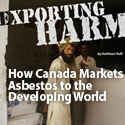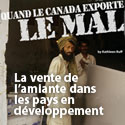Kathleen Ruff, RightOnCanada.ca
The Erratum states that evidence cited by the authors is non-existent
Stefania Boccia and Carlo La Vecchia, the Editors-in-Chief of the Italian scientific journal Epidemiology, Biostatistics and Public Health (EBPH), have published an Erratum in their current issue regarding false information in an article on chrysotile asbestos, Critical reappraisal of Balangero chrysotile and mesothelioma risk, by Edward B. Ilgren et al. This is the 2nd Erratum published for this article. Earlier, following a complaint regarding undisclosed conflicts of interest, the authors were required to publish an Erratum to disclose their extensive financial ties to asbestos interests.
The article claims that cases of mesothelioma contracted by workers and nearby residents of the Balangero chrysotile asbestos mine in northern Italy were not caused by chrysotile asbestos and that the workers and residents must have been exposed to other forms of asbestos, which must have caused the harm. The article states that “Crocidolite and amosite (asbestos) were also transferred to Balangero in jute bags.” The authors cite an article, Mining and milling chrysotile asbestos: the history of the Balangero asbestos mine in Italy by Silvestri et al., as providing evidence to substantiate their statement.
The article the authors cite provides no such evidence.
ERRATUM
Stefania Boccia, Carlo La Vecchia
Critical reappraisal of Balangero chrysotile and mesothelioma risk. Edward B Ilgren, Frederick D Pooley, Yumi M Kumiya, John A Hoskins, DOI: 10.2427/10125
There is an erroneous citation at page 5: “Crocidolite and amosite were also transferred to Balangero in jute bags [11].” This statement cannot be found in Ref. 11.
EBPH is the official journal of the Italian Society of Medical Statistics and Clinical Epidemiology (SISMEC). The editorial board of SISMEC instructed Boccia and La Vecchia to publish the Erratum. Boccia and La Vecchia were aware that the information they had published was false, but failed to correct it and allowed Ilgren and his co-authors to publish a second piece in EBPH which continued to hide the fact that the information was false. As a result of the instruction by SISMEC, Boccia and La Vecchia have now published the Erraturm, one year after the publication of the article.
Italian Society of Medical Statistics and Clinical Epidemiology asked to uphold ethical and scientific standards
A complaint was made to EBPH and SISMEC regarding scientific and ethical improprieties in the Balangero article and another article on asbestos by Ilgren et al. published by EBPH. In their complaint, scientists called on SISMEC to take action to ensure that its journal would uphold scientific and ethical standards.
The president of SISMEC, Franco Cavallo, stated that the executive committee of SISMEC had expressed concern to the Editors of EBPH about the asbestos articles by Ilgren et al. and had issued a warning to EBPH concerning its peer-review process. With regard to the false information about sacks of crocidolite and amosite asbestos, Cavallo said that “We have asked the Editors to publish an erratum and blame the authors for having altered the citation, giving a misleading interpretation of what was actually written.”
“Our Society has decided to engage in a serious commitment toward the safeguard of our ethical standards,” said Cavallo.
Action taken by SISMEC is weak and inadequate
The Erratum published by EBPH does not comply with ethical or scientific standards. It is weak and misleading and fails to address the seriousness of the wrongdoing. The Erratum makes it appear that there was simply an erroneous citation. It does not address the fact that:
- The authors have no evidence to support their claim that sacks of crocidolite and amosite asbestos were transferred to Balangero. This is not an example of a minor error in a citation. This is an example of deliberately invented false information which serves the interests of the asbestos industry.
- When an article contains invented, false information, which serves the interests of the industry which funds the authors, a responsible journal should retract the article, as scientists asked EBPH to do. At the very least, the journal has an obligation to act responsibly and transparently and disclose the seriousness and significance of the wrongdoing. EBPH has failed to do that.
- The Ilgren et al. article, with its deliberate falsification of evidence, continues as an article published on the EBPH website without any Errata being part of the article.
- The article with its deliberate falsification of evidence is being promoted by the asbestos industry to serve its interests and is very beneficial for the industry’s continuing production, sale and export of two millions tons of chrysotile asbestos every year, almost all it used in low income countries, where workers and populations lack information and protection from asbestos harm.
- SISMEC’s journal and reputation are being used to promote harm to health of people in low income countries. This represents a failure of solidarity and a betrayal of public health protection – matters that SISMEC should take seriously.
- In a letter of October 9, 2015 to SISMEC, scientists pointed out that EBPH had published a second piece by Ilgren et al. in response to a Letter to the Editor criticizing misinformation in the original Balangero article. The Letter to the Editor exposed the fact that the information EBPH had published regarding sacks of crocidolite and amosite asbestos being transferred to Balangero was false. In their second article in EBPH in response to the criticism, Ilgren and his co-authors failed to correct the false information. Apparently they have no problem putting forward false information that serves the asbestos industry. What is particularly shocking, is that the Editors-in-Chief of EBPH, even though they had been notified that the information they had published was false, did not require the authors to correct the false information.
- In their letter to the President of SISMEC, the scientists stated that publishing an Erratum would be an insufficient response to such serious and deliberate wrongdoing and that SISMEC, as an oversight body, should underline the seriousness of the misconduct by Ilgren et al. The scientists stated: “Refusing to correct false information, after it has been pointed out to the authors that it is false information, constitutes deliberate dishonesty and, in our opinion, is unacceptable conduct under even the lowest scientific and ethical standards. It is a betrayal of science and a betrayal of the public trust.”
- The scientists stated: “SISMEC should not tolerate, in our opinion, that its journal serves asbestos interests and endangers the health of populations. Surely there has already been sufficient wrongdoing in Italy and other countries with regard to distorting the evidence regarding asbestos risks and harming workers, without SISMEC adding to it?”
- Asbestos interests spend tens of millions of dollars for scientists to write articles that deny harm caused by chrysotile asbestos and claim that “anything but chrysotile (ABC)” has caused harm. Workers and populations who are exposed to harm from chrysotile asbestos do not have tens of millions of dollars to spend to defend their right to health. Instead, they depend on scientists and scientific organisations to show integrity and uphold scientific and ethical standards.
Joint Editor-in-Chief failed to disclose his financial ties to asbestos interests
It is significant that, similarly to Igren and his co-authors, the joint Editor-in-Chief of EBPH, Carlo La Vecchia, and his co-author, Paolo Boffetta (an Executive Editor of EBPH), published an article in the European Journal of Cancer Prevention, Role of stopping exposure and recent exposure to asbestos in the risk of mesothelioma, which served asbestos interests and did not disclose that the authors were paid consultants for these asbestos interests. When asked to publish an Erratum to disclose their conflicts of interest, La Vecchia and Boffetta refused to do so. A complaint was therefore submitted to the publisher of the journal and La Vecchia and Boffetta were finally, two years after publication of the article, forced to publish an Erratum to disclose their conflicts of interest.
It is more than disappointing that SISMEC ignored requests from scientists that it address the issue of the false information seriously and that it has turned a deaf ear to the request that it urgently set up an open and transparent process to put in place clear and effective ethical standards for both the organisation and the journal.
Scientific journals and scientific organisations, such as SISMEC, should be leaders to uphold scientific and ethical standards. EBPH and SISMEC are doing the opposite.



February 6th, 2016 at 11:50 am
This is very good article and come in time for asbestos ban advocacy movement in Vietnam. We ask the author, Kathleen, for giving us permission of translating it into Vietnamese so that we could use it as a reference document for the course on research ethics in policy advocacy which will be organized in Hanoi Vietnam by April 6-10, 2016.